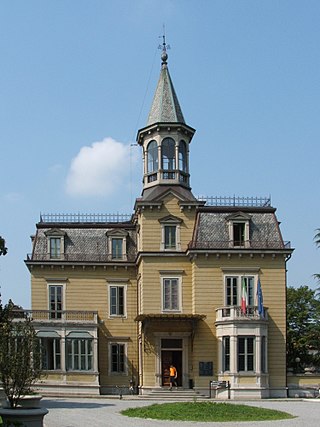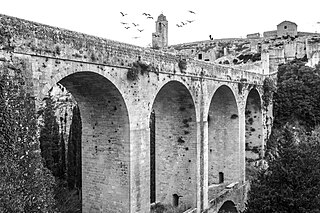
Rimini is a city in the Emilia-Romagna region of Northern Italy.

The Doge's Palace is a palace built in Venetian Gothic style, and one of the main landmarks of the city of Venice in northern Italy. The palace was the residence of the Doge of Venice, the supreme authority of the former Republic of Venice. It was built in 1340 and extended and modified in the following centuries. It became a museum in 1923 and is one of the 11 museums run by the Fondazione Musei Civici di Venezia.

Sorrento is a town overlooking the Bay of Naples in Southern Italy. A popular tourist destination, Sorrento is located on the Sorrentine Peninsula at the south-eastern terminus of the Circumvesuviana rail line, within easy access from Naples and Pompei. The town is widely known for its small ceramics, lacework and marquetry (woodwork) shops.
This article contains information about the literary events and publications of 1565.

Cannaregio is the northernmost of the six historic sestieri (districts) of Venice. It is the second largest sestiere by land area and the largest by population, with 13,169 people as of 2007.

The Grand Canal is a channel in Venice, Italy. It forms one of the major water-traffic corridors in the city.

Comacchio is a town and comune of Emilia Romagna, Italy, in the province of Ferrara, 48 kilometres (30 mi) from the provincial capital Ferrara. It was founded about two thousand years ago; across its history it was first governed by the Exarchate of Ravenna, then by the Duchy of Ferrara, and eventually returned to be part of the territories of the Papal States. For its landscape and its history, it is considered one of the major centres of the Po delta.

Centallo is a comune (municipality) in the Province of Cuneo in the Italian region Piedmont, located about 60 kilometres south of Turin and about 13 kilometres north of Cuneo.

Zanica is a comune (municipality) of around 8,804 inhabitants in the Province of Bergamo in the Italian region of Lombardy, located about 45 kilometres (28 mi) northeast of Milan and 7 kilometres (4 mi) south of Bergamo. Zanica borders the following municipalities: Azzano San Paolo, Cavernago, Comun Nuovo, Grassobbio, Orio al Serio, Stezzano, Urgnano.
Cesarina Ricci de Tingoli was an Italian composer of the Baroque period.

Sant'Onofrio al Gianicolo is a titular church in Trastevere, Rome. It is the official church of the papal order of knighthood Order of the Holy Sepulchre. A side chapel is dedicated to the Order and a former grand master, Nicola Canali is entombed there. It is located on the Janiculum. Since 1946, the church has been under the care of the American congregation of the Franciscan Friars of the Atonement.

The Bridge of Tiberius, historically also the Bridge of Augustus or the Bridge of Saint Julian, is a Roman bridge in Rimini, in the region of Emilia-Romagna, northern Italy.

Paolo Domenico Finoglia, or Finoglio, was an Italian painter of the early-Baroque period, active mainly in South Italy, including Naples and towns in Apulia.

The Ponte della Costituzione is the fourth bridge over the Grand Canal in Venice, Italy. It was designed by Santiago Calatrava, and was moved into place in 2007, amid protest by politicians and the general public. The bridge was installed in 2008 and opened to the public on the night of September 11, 2008. The bridge was known as Quarto Ponte sul Canal Grande before the official name was adopted to celebrate the 60th anniversary of the Italian constitution in 2008. Tourists and locals in Venice now refer to it as the Calatrava Bridge.

The Church of St Job is a 15th-century Roman Catholic church located overlooking the campo of the same name, known as Sant'Agiopo in Venetian dialect, on the south bank of the Cannaregio canal near Ponte dei Tre Archi in the sestiere of Cannaregio of Venice, northern Italy,
Luigi Boscolo was an Italian engraver, active in Venice.

Luigi Busi was an Italian painter born in Bologna.

The Canal Grande is a navigable canal located in the heart of the Borgo Teresiano, in the very center of the city of Trieste, approximately halfway between the railway station and Piazza Unità d'Italia. The Canal Grande was a key element of the new urban plan that led to the construction of Borgo Teresiano.
Giovanni Battista Manso was an Italian aristocrat, scholar, and patron of the arts and artists. He was for many years the leading figure in Neapolitan poetic and intellectual circles.

The Ponte Madonna della Stella, also known as the Ponte Acquedotto Madonna della Stella, Ponte Viadotto-Acquedotto Madonna della Stella, or simply il ponte di Gravina, amongst other combinations, is an eighteenth-century bridge and aqueduct over the Gravina in the southern Italian town of Gravina in Puglia.


















